I hope you all have your CNRS Nouragues Travel grant applications ready! The due date is Valentine’s Day! Tropical fieldwork is the perfect way to warm up when you are freezing your ass off.
Download your application by clicking here.
I hope you all have your CNRS Nouragues Travel grant applications ready! The due date is Valentine’s Day! Tropical fieldwork is the perfect way to warm up when you are freezing your ass off.
Download your application by clicking here.

The Red-throated Caracara, Ibycter americanus, is the subject of my academic research and the namesake of this blog.
This beautiful raptor may look like a strange vulture or a hawk, but it is actually in the falcon family. It is classified in the subfamily Polyborinae. This group includes the caracaras, forest falcons and some others, and is thought to have split from the rest of the falcons some 14 million years ago . The caracaras are oddballs in the falcon world, as they are not swift-flying, long-winged aerial hunters, but for the most part rather slow-flying generalists and scavengers, many of whom spend a lot of time walking on the ground. There are currently five recognized genera of caracara, with 10 species.
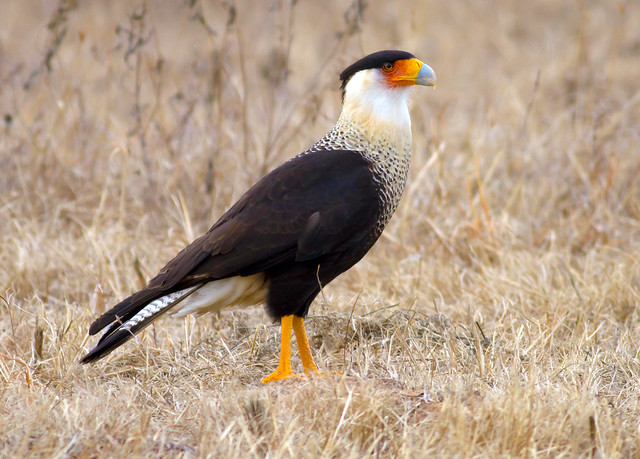
This is a Crested Caracara, Caracara cheriway. These birds are more typical of the group, found in open habitats. (photo CC Licenced by Manjith Kainickara)

This Yellow-Headed Caracara, Milvago chimachima is a smaller generalist predator, also found in open habitats. A beautiful photo by Bart vanDorp, taken in Minas Gerais, Brazil.
Caracaras are for the most part birds of open habitats, from windswept Patagonian plains to sunbaked Venezuelan llanos to the open cattle country of Central Florida. Bucking this trend, the Red-throated Caracara is a forest specialist, preferring densely forested habitats from Central America to southern Brazil. And unlike most of its relatives, it is not a generalist predator or a scavenger, but rather a specialist predator of social wasps. This unusual diet is mirrored in the Old World by the Honey Buzzards, of the genus Pernis. It is this unusual dietary choice which led to me taking on my PhD research, the main objective of which was to determine how these caracaras manage to prey on well-defended social wasps without getting injured.
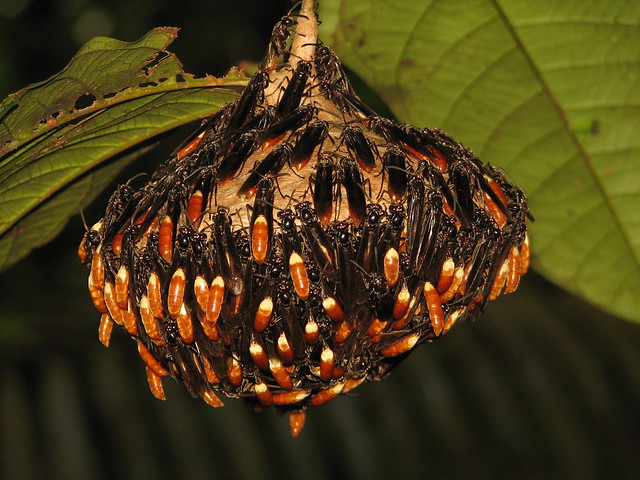
The warning coloration of these Apoica albimacula tell most predators to stay away, and with good reason.
In addition to the diet, the social behavior of Red-throated Caracaras also stands out. Unlike most falcons, this species is rarely seen alone, preferring to travel in groups of up to 15 birds. They are extremely loud birds and are in almost constant vocal communication with each other. If you want to hear what I am talking about, listen to this!

Yeah, we bad… The Red-throated Caracara is one of the most sociable (and loud) raptors you are ever likely to meet.
This species, and most caracaras in fact, have rarely been studied. Prior to my work on these strange birds, only one study has focused on their behavior, showing that they exhibited some degree of cooperative breeding, and that they appeared to be defended against their social wasp prey by “a powerful chemical repellent”.
Because I have become so enamoured of these caracaras, I would like their tale told more widely, and this blog will be one of the vehicles to do so. In some upcoming posts, I will begin to tell the story of my research on these (ridiculously cool) animals. My research has been a fascinating journey, which is not over yet. You are most welcome to tune in to future posts to learn more about the world of the Red-throated Caracara.
References

This shot of a sharpshooter, Oncometopia nigricans, was taken with a compact superzoom and a Raynox DCR 250 lit with the onboard flash and some styrofoam bowls (see below).
Much of the reason I got into photography is the desire to document the wonderful world of insects. This is the realm of macrophotography and is a great one for beginners to get into, because stellar results can come from even modest equipment (provided you are willing to work to achieve them).
One of the best pieces of equipment to get going in macro is the Raynox DCR 250. This marvelous piece of glass fits on the front of a lens and allows you to snap some great high magnification shots. If you are hesitating about getting a macro lens, but still want to get some nice closeups, this is your tool. It costs about 70-90 bucks.
These types of attachments are often called “diopters” or “close-up filters”, but the difference between these and most others on the market is that these ones don’t suck . They are a 3 element design, and are multi-coated for good contrast and flare control. When using this lens adapter, you use your zoom to set your magnification, and then the focus for the close work. Using my DSLR with it attached to the front of my 18-55 IS (kit zoom), I can fill the frame with something 35 mm across. This is not quite 1: 1, but getting there.
If you do not have an SLR, fear not! It also makes a wonderful attachment for compacts, especially the so called “superzooms”. You may need a special adapter to fit it to, but once it is on, the strong telephoto character of the superzoom allows some pretty good closeup ability.
My early days shooting macro I used the combination of the Raynox and a Canon S2IS extensively. I loved the versatility of this combination, and I sometimes still miss it! Below is a monstrously ugly photo I once took of that setup. Here you can see the styrofoam bowl which acts as a flash diffuser for the onboard flash fitted around the bayonet adapter,. The Oncometopia nigricans photo at the top was taken with this setup, as were many of my favorite macro shots.
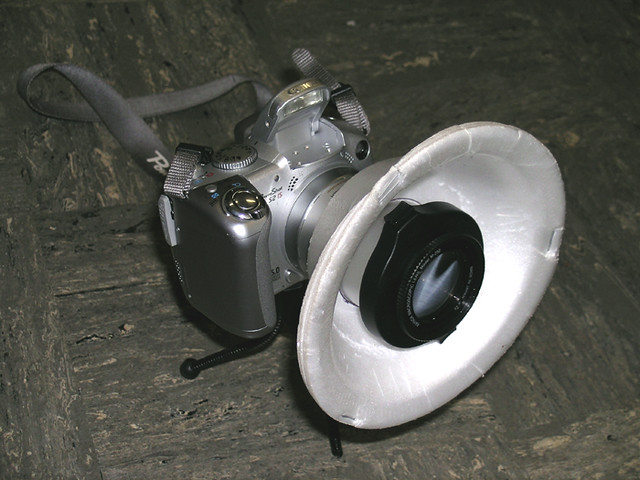
Below you can see the Raynox itself. It comes shipped with a clip on adapter (visible in the shot above) to mount it to various sized filter threads, but this is somewhat flimsy and will break at some point. The interior portion is threaded, so you can just get a step-up ring from 43 mm to whatever size filter thread you want to attach it to.
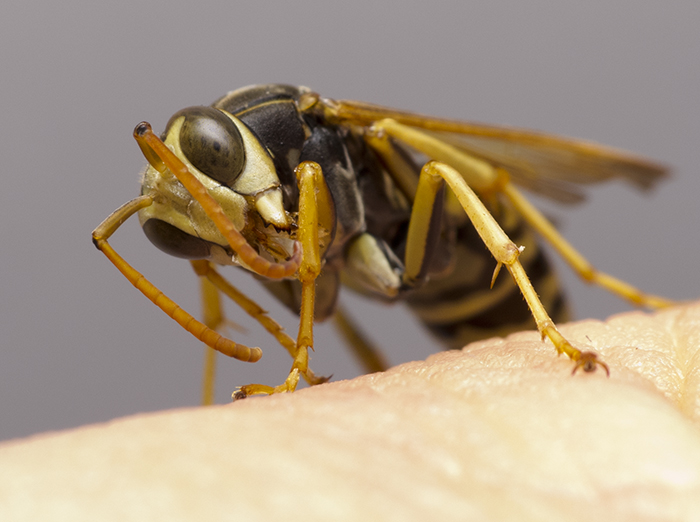
Here is a shot I took yesterday of a Polistes aurifer (from the lab!) using a borrowed (thanks Mike!) Canon G12 and Raynox DCR250. The light is the YN460 with the Cheapskate diffuser featured in last week’s Cheapskate Tuesday.

This is a subject that is close to home for many of you, the Cellar Spider, Pholcus phalangiodes shot last night with a Canon A720, the styrofoam bowl diffuser, and onboard flash.

The same Polistes aurifer male from the lab, this time shot with my DSLR and the inexpensive EFS18-55 IS with Raynox DCR 250, also lit with the Cheapskate Diffuser. This same lens combo is often used to stunning effect by Techuser, a.k.a. Brazilian nature photography guru João P. Burini of Primal Shutter.
To sum up, the Raynox is an adaptable piece of equipment, and unlike many macro adapters, this one is actually good. I no longer have one of these, having given mine away a couple years back to an aspiring macro shooter from French Guiana, but picking it up again to write this up makes me nostalgic. I think I will have to end with a gallery of some of my favorite shots with this awesome little lens.
This weekend expedition was much like any you might venture to make on a winter day in Vancouver: grey and rainy! The rain was not severe though, so with the camera protected by a big umbrella, I headed out with Wild Research for a birdwatching trip led by Elly Knight, a grassland songbird researcher at SFU. The mission today was to get out and see some waterbirds as well as some passerines that make their homes in wintertime Vancouver. I was along to document the fun, as well as to offer my own, often unreliable, ID help! Click on any image below to see a gallery of the resulting shots.

The first and only time I saw this beautiful arboreal pitviper was on the last day of last year’s field season. This shot required running down to the Grand Plateau an hour before the chopper arrived. This is Bothriopsis bilneata (formerly Bothrops bilineatus)
Over the past few years, during my fieldwork in French Guiana, I have been on the lookout for snakes. As a child, I always loved these animals, having kept several as pets. In fact, like many entomologists, I first wanted to be a herpetologist!
In the field, there are snakes to see, but for better or for worse, I usually only see 2-3 per month of fieldwork. This past field season, perhaps because we were covering 7-16 km per day most every day, we did encounter more than that. Please enjoy this selection of French Guianan serpents that we saw this field season:

My first anaconda! This was actually spotted by an ONCFS director (Jean-Marie), somehow…It is just a small one. Eunectes murinus

A small nonvenomous colubrid, said to be a mimic of the venomous Bothriopsis bilineata at the top of this post. This is Xenodon werneri
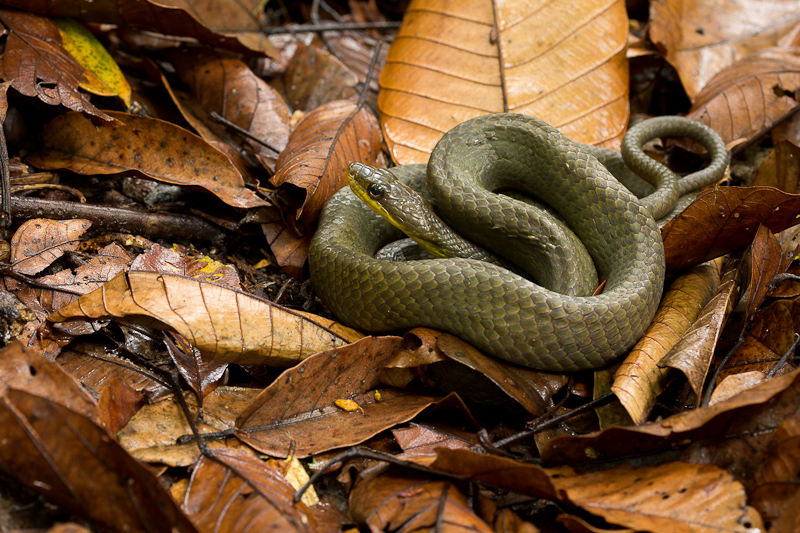
Pseustes poecilonotus…Kinda like a rat snake, I suppose, but maybe a bit more active. This shot was exposed at a couple seconds, steadied with a tripod.

Gorgeous, eh? Oxybelis fulgidus… Somewhat venomous arboreal colubrid with dreamy yellow eyes.

Here is a Bothrops atrox. This one I almost stepped on. My boot was within 1 m of this animal, but it did not bite. Catherine spotted it after my careless blunder!

The rain started pouring shortly after the first shot, so with our transect scrubbed, I put the camera in a bag on the tripod and kept shooting.
Note on Snakes and the danger posed by them:
Some of the most common questions I get about work in the tropics is “what about snakes? Are there lots of them? Are you afraid?”
Well, yes, of course there are snakes, and yes, there are a lot of them, but no, for the most part, I am not terribly afraid…
Lets be clear, it is a very remote area to work in, and it takes at least 40 minutes for a helicopter to fly out and get you, assuming one is available and it is not crappy weather or nighttime. A snakebite could very well be a very very bad thing indeed.
That being said, with a few sensible precautions, snakebite is very unlikely (or that is what I like to tell myself anyhow). First of all, do not handle the snakes, especially the dangerous ones or the ones you do not recognize to be harmless. This should be obvious. There is probably no good reason to be handling them anyhow, unless they are what you are studying.
Secondly, do try to watch where you are going, and watch where your feet fall. Even with some of the most cryptic species, you can often see them before you step on them (I think you can anyway…I have seen a few anyhow. If I did step on some I did not suffer for it…)
Thirdly, I like to think that the wearing of high boots may ward off some bites, at least of smaller specimens. I generally wear high rubber boots in the forest, as they are cheap, durable and waterproof. They are also pretty tough, and while they probably would not stop all fangs from entering the skin, they might at least make some of the small ones glance off. I always try to look where I am going, and I always use a headlamp or flashlight at night.
Chances are, you won’t get bit… BUT!
it could happen, and it would probably suck, so a little healthy fear is probably a good thing….

Speaking of nighttime and venomous serpents, this is a Bushmaster Lachesis muta or “silent fate”. This species is one of the biggest venomous snakes in the world. Contrary to its binomial, it is not really silent, and in fact has a hardened horny tail, which it vibrates rapidly to produce quite a loud sound.

You really do not see these beauties too often, as they are nocturnal. They are one of the best reasons to always use a lamp!
For more snakey goodness from the internet today, click here
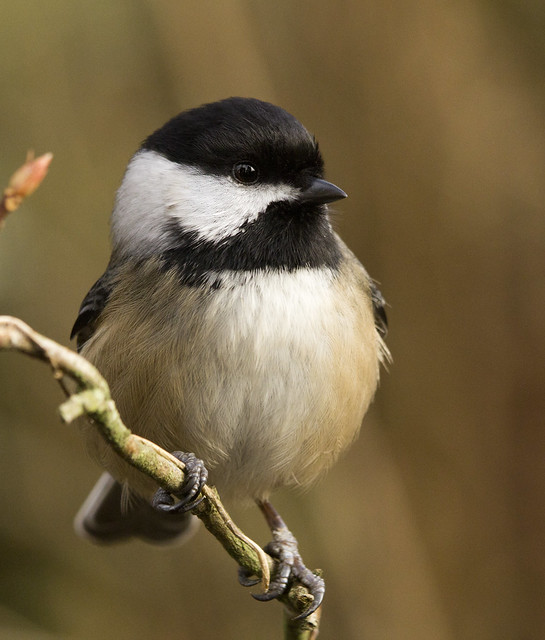
Wild Research is a local consultancy group offering environmental services as well as public education. I have been invited along as an event photographer for some local bird identification trips. The second such trip (Saturday!) is to Vancouver’s famous Stanley Park, which is a great location for both waterbirds as well as forest species. It is also one of my favorite photography destinations.
Hi, and welcome to Cheapskate Tuesday! Here I will try to convey how I mess up my photos by cheaping out I save money by applying a DIY ethic to photography projects. I plan to explain as many of my tricks as I can, and then will scour around teh internets for cool looking budget-minded photo mods and tricks.
This week, another version the ever popular macro flash diffuser…There are endless varieties, but the whole purpose of them is to enlarge the size of the (small) light source relative to your (probably small) subject, improving the quality of light by filling in shadows and reducing specular highlights.
I will admit, this idea is not wholly my own. When I read this post by Piotr Naskrecki (one of the greatest close-up shooters around) and he mentioned using file folders to diffuse speedlights, I immediately went out to the dollar store to find some…I am not sure if I found the same ones, but here is what I riffed off of that:
This badboy you can build for roughly two dollars. So say you have your flash, and since you are budget minded it is a beat up Yongnuo 460-II (35 bucks used, baby)…

First things first…You have velcro around the flash head, right? If not, put some there… This will be important later. I like to use the soft side, because sometimes I cuddle up with my speedlights.
Next, you need to get a file folder such as this:
Look for yours at a dollar store, or budget office supply store. The key feature of this is that it has a white plastic interior…It is almost the thickness of paper, but it is a nice tough white plastic… I have no idea what the composition is, but the stuff is tough! It supposedly is imported by DTSC Imports in Burnaby BC, and made in China.
Next, tear away all the pink and transparent plastic, leaving two beautiful sheets of white plastic:

Next, fold one of the white sheets so that the two shorter sides meet midway…Give it a good crease.
Next, cut two flash-head-sized pieces of self adhesive velcro (the hook side this time!)
Stick those about where you might expect them to go:
Make a few, throw em in your bag, and there you go.
I like this modifier in particular because it stores as flat as a sheet of paper. The plastic is so tough, you don’t have to worry about it tearing, and it won’t get dirty like fabric-covered softboxes. Also it costs 50 cents….
I made extensive use of this simple mod on my recent field excursion to French Guiana, and appreciated the simple stowing and quick deployment this device offered. Here are some examples of what it can do:
Note: you could probably use the pink translucent stuff to gel your flash for some really weird looks, or perhaps for other arts ‘n’ crafts. The transparent stuff might make a good humidifying cover for an insect cage, or whatever else you might use transparent plastic for. Good luck and good shooting!
The weekend expedition was a great success. Marie Burle, Willow English, Mike Boers and myself set out for Delta, where the swampy farmland meets the muddy waters of Boundary Bay. . This site is a great place for birds of prey, especially in the winter. We endured cold cloudy weather, but were rewarded with sightings of three owl species, harriers, a Cooper’s Hawk, Red-Tailed Hawks, and many eagles…. The Snowy Owls, which have been abundant at this site both this year and last, were for the most part far off near the shore. We did spot a few, including this one which flew right over our heads. Without a doubt, the highlight of the trip was sighting these wonderful little Long-Eared Owls. Just as we were about to drive away, Marie, a fellow researcher at SFU , spotted the first owl hidden in a tree right next to the car. To our surprise, there were actually three of them perched within 1 m of each other. Shooting was difficult, due to a fence and many blackberry bushes, but we managed to shoot some decent exposures. A brief visit with Sofi Hindmarch, another raptor biologist ended a great weekend expedition.
Results: see above.
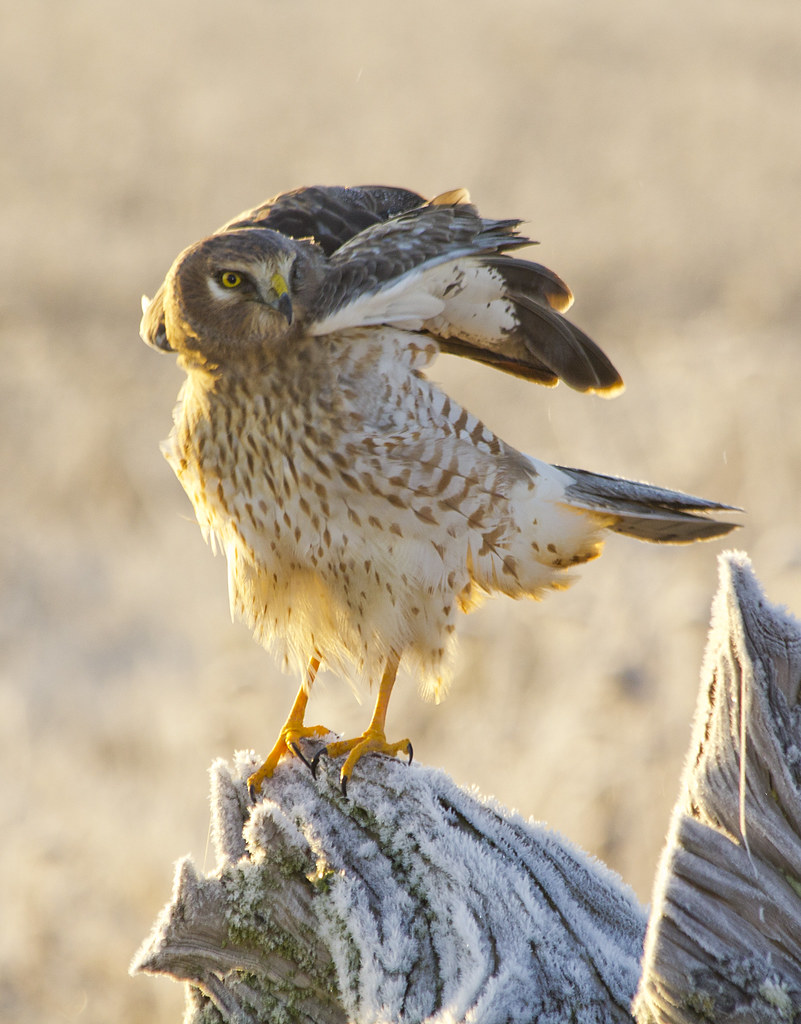
It is cold in Vancouver!
I am planning on going out to Boundary Bay on Sunday to photograph some raptors… In the meantime I will be doing thesis chapters and grant applications.
What are you up to?

10/10 ant-mimicking mantids recommend tropical fieldwork. Canon 60D, 100 mm macro diffuse speedlight on subject, 2nd speedlight illuminates background
At this stage of the long dark Canadian winter, thoughts of tropical fieldwork should be going through the heads of all sensible entomologists…If you find yourself longing for the moist and humid insect filled paradise of the Neotropics, or even if that is what your research plans call for, let me introduce you to the wonders of French Guiana.
French Guiana is situated just north of Brazil on the Atlantic coast of South America, and remains to this day an overseas Department of France. Both French and Creole are spoken, so Canadians should feel right at home.
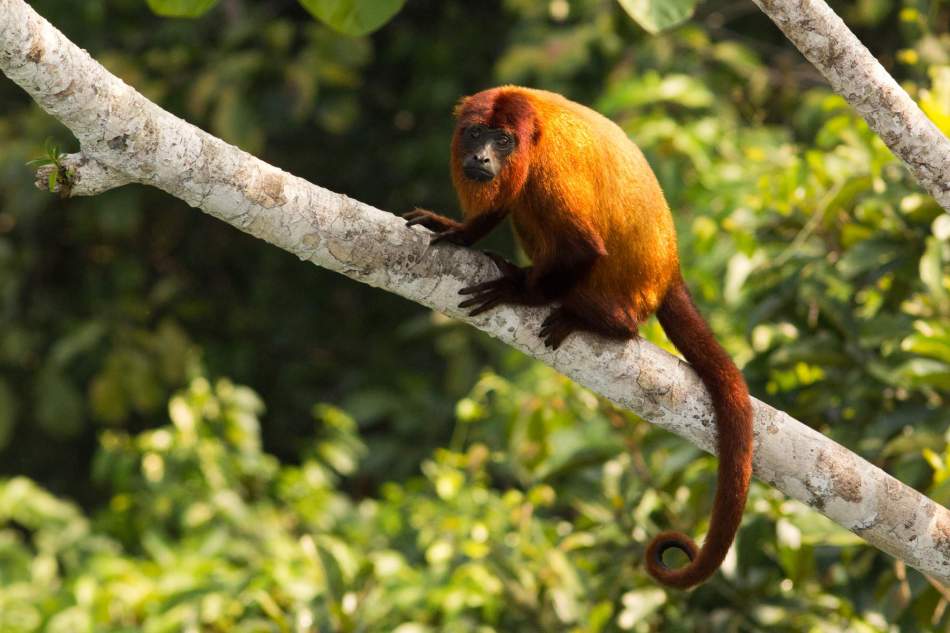
The reserve is off limits to hunters, so large populations of monkeys and other large vertebrates are still present. Canon 60D, 300mm f4 L
French Guiana truly shines as a biodiversity and natural areas hotspot because unlike many countries in the Amazonian forest region, it has not experienced extensive deforestation. The immense expanses of unlogged rainforest are truly impressive.
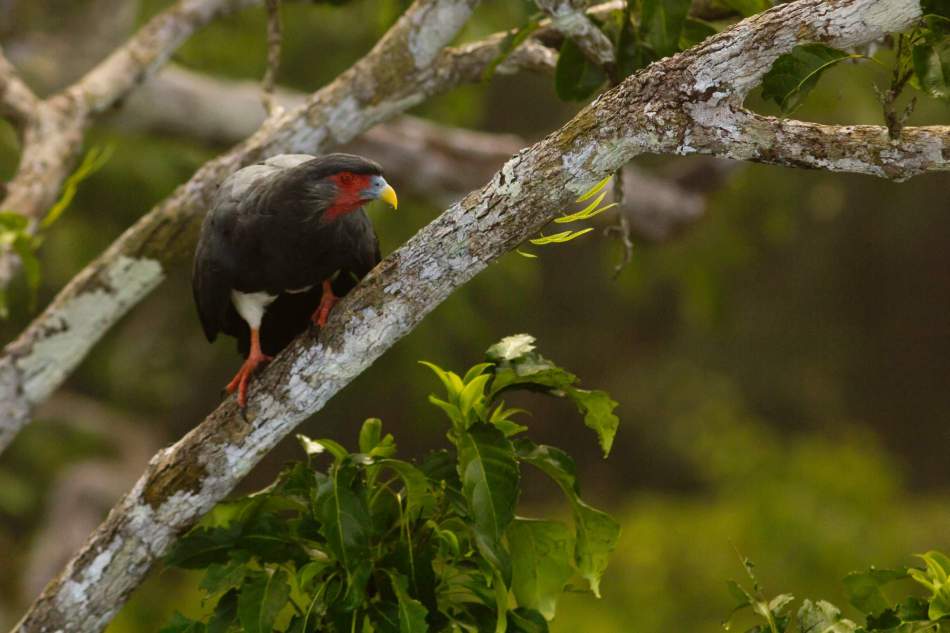
The Red-throated Caracara, a specialist predator of social wasps is abundant (and awesome). Canon 60D, 300mm f4 L
I have done all my tropical fieldwork at the Nouragues station, supported by an annual grant program that seeks to assist visiting scientists with the travel and logistical expenses involved with a tropical field season. If the pictures above do not whet your appetite, please feel free to browse a more extensive collection here.
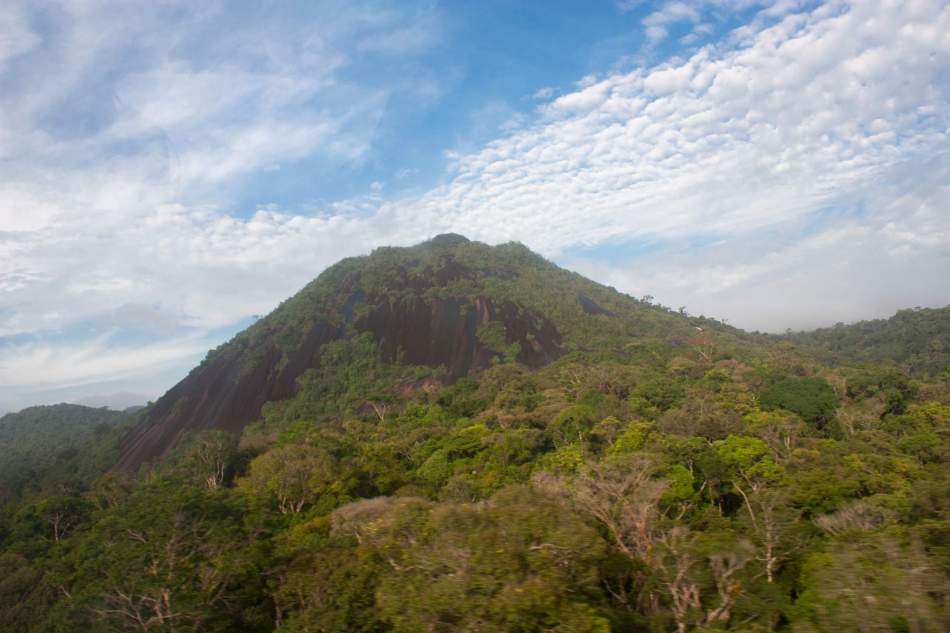
Inselberg des Nouragues at The Nouragues Reserve: the camp is right below this impressive rock. Canon 450D, 18-55 IS, helicopter
The 1000 km 2 Nouragues reserve is located approximately 100 km SSW of Cayenne, and was established in 1995 to be both a refuge free of development and to facilitate research on Neotropical forest dynamics.
There are two research camps, the Inselberg Camp, situated just beneath a 420 m granite mountain, the Inselberg des Nouragues, and the camp at Saut Pararé, situated just below a series of high rapids on the Arataye River. The camps are accessible by helicopter, or you can take a motorized canoe (pirogue) to the Saut Pararé camp. Both camps are administered by the CNRS (Centre Nationale de Recherche Scientifique) which has an office in Cayenne. Field costs are €20/day for students and postdocs and €35 per day for established researchers. Travel to the station can be expensive, but sharing the cost of helicopters/pirogues with other researchers can bring the costs down considerably.

Motorized pirogues can take you up and downriver. The skill of these boat crews as they navigate the rock filled channels is amazing to behold. Canon 60D, 18-55 mm IS
Access to various parts of the forest is facilitated by an extensive trail system (see map). Data on tree species and flowering/fruiting phenology in two large research plots at the Inselberg Camp are available. At the Parare camp, there are many trails, although not as extensive as at the Inselberg camp, as well as access to riverine and palm swamp habitats. Lists of species of birds, bats, fish and trees are available, and there is an impressive list of scientific data already published.
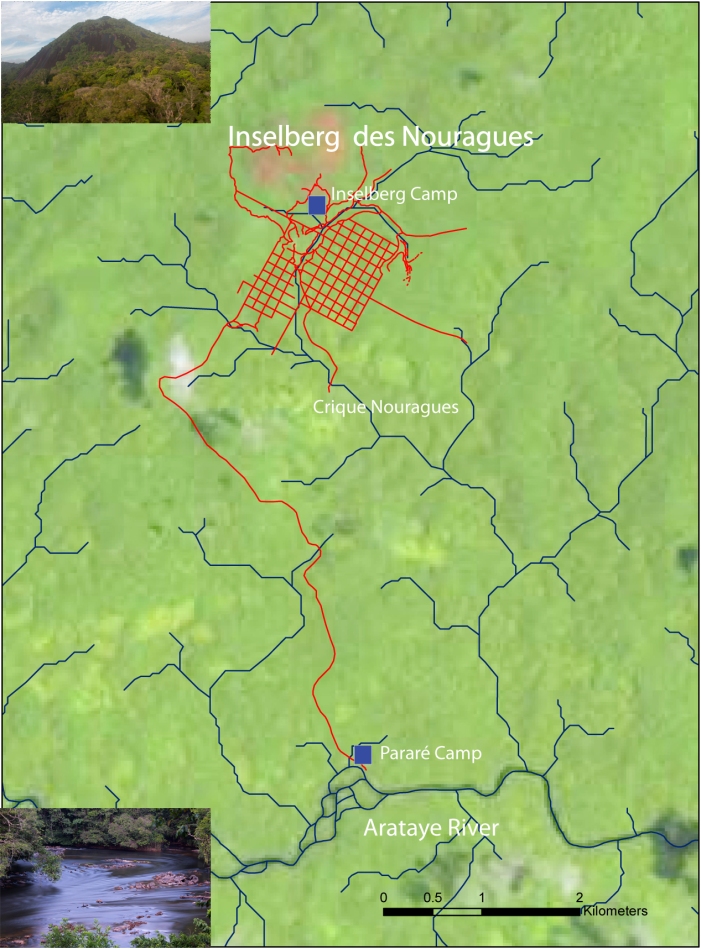
The two camps in the Reserve. Trails marked in red. ArcView with some Landsat Imagery and trails courtesy of Valentine Alt
The camps are comfortable, with covered shelters (carbets) for sleeping and eating, and there is electricity and running water at each station (it is the rainforest!). There is also a satellite internet connection which is adequate for email and keeping in touch with labs and colleagues. Food is provided, and is quite good (as one might expect at a French field station!), cooking/cleaning duties are shared.
If you are a student or a researcher at the planning or pre-planning stages of a Neotropical research program, there is no better time than now to submit a research proposal to the scientific committee of the station. The recently announced call for proposals will fund projects to a maximum of €9000, which would nicely cover the transportation and field costs for a several-month expedition. The deadline is Feb. 14, 2013. For more information, the details are available here.